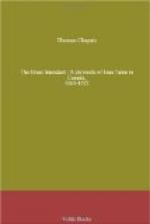Another feature of Talon’s relations with the clergy and religious communities—and a pleasant one this time—was his strong interest in the francisation (Frenchification) of the Indians. It was Colbert’s wish that efforts be made to bring the Algonquins, Hurons, and other Indians more closely within the fold of European civilization—to make them alter their manners, learn the French tongue, and become less Indian and more European in their way of life. Talon was of the same mind and lost no opportunity of impressing the idea on those who could best do the work. Laval had already been active in the same direction, and had founded the Quebec Seminary partly with this end in view. The great bishop thought that one of the best means of civilizing the Indians would be to bring up Indian and French children together. So he withdrew from the Jesuits’ College a number of pupils whom he had previously placed there and established them, with a few young Indians, in a house bought for the purpose. Such were the beginnings of the Quebec Seminary, opened on October 9, 1663. The first class consisted of eight French and six Indian children. The seminary trained them in the practice of piety and morality. For ordinary instruction they went to the Jesuits. The Jesuits’ College had been founded in 1635 and was of great service to the colony. It was pronounced by Laval in 1661 almost equal in educational advantages and standing to the Jesuits’ establishments in France; and according to a trustworthy author it ’was a reproduction on a small scale of the French colleges: classes in letters and arts, literary and theatrical entertainments, were found there.’ Some of the public performances given at the Jesuits’ College were memorable, such as the reception to the Vicomte d’Argenson when he entered upon the government of New France, and the philosophical debate of July 2, 1666, which was graced with the presence of Tracy, Courcelle, and Talon. Two promising youths, Louis Jolliet and Pierre de Francheville, won universal praise on that occasion; and Talon himself, who had been accustomed in France to such scholastic exercises, took part in it very pertinently, to the great delight of all present.
To return to the francisation of Indians: the Ursulines were also enlisted in the cause. Since their arrival in Canada in 1639 it had been for them a labour of love. In the convent and school founded by Mother Marie de l’Incarnation and Madame de la Peltrie, both French and Indian girls received instruction in various subjects. Seven nuns attended daily to the classes. The Indian girls had special classes and teachers, but they were lodged and boarded along with the French children. Some of these Indian pupils of the Ursulines afterwards married Frenchmen and became excellent wives and mothers. Special mention. is made of one of the girls as being able to read and write both French and Huron remarkably well. From her speech it was hard to believe that she was born an Indian. Talon was so delighted with this instance of successful francisation that he asked her to write something in Huron and French that he might send it to France. This, however, was but an exceptional case. Mother Mary declared in one of her letters that it was very difficult, if not impossible, to civilize the Indian girls.




